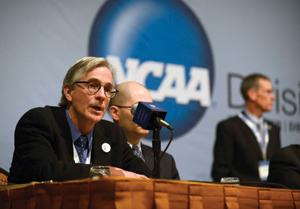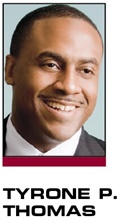The NCAA has announced the establishment of a new chief medical officer position, held by Dr. Brian Hainline, who started in January. According to the NCAA, a key component of Hainline’s work will be the creation of a “center of excellence” to serve as a national resource providing safety, health and medical expertise to physicians and athletic trainers.
Although the NCAA has highlighted Hainline’s overall sports medicine background from his most recent position as chief medical officer of the U.S. Tennis Association, it is his technical training that should be noted by every member institution. Hainline is a specialist in the area of neurology and integrative pain medication, professional training that provides expertise in the area of concussions. In fact, Hainline previously served as an investigator under the Retired NFL Players Concussion Study.
Health concerns arising from concussions have been headlined with the NFL in both litigation and labor negotiations. A complex and potentially costly litigation was filed on behalf of former players, and the NFL has enacted several rules changes and monitoring procedures to assess players diagnosed with head injuries. Yet, the NCAA has been in the background of the concussion discussion, even though such injuries are not foreign to the collegiate level.
 |
Dr. Brian Hainline’s background is in neurology and integrative pain medication.
Photo: PETER LOCKLEY / NCAA PHOTOS
|
The filing of a large and now consolidated class action in Illinois against the NCAA has highlighted legal vulnerability. A set of initial class actions filed by former student athletes Adrian Arrington and Derek Owens alleged the NCAA was negligent in safeguarding student athletes from the risks of concussions. The plaintiffs claim the NCAA not only failed to educate coaches, trainers and student athletes on concussions, but that it also failed to implement systemwide guidelines to evaluate such injuries and did not establish any guidelines to address when student athletes could return to competition.
The NCAA publishes the Sports Medicine Handbook, which addresses various medical issues, including best practices for a concussion management plan. However, the handbook does not provide a comprehensive standard protocol to be used by every member institution with respect to workouts, practices and athletic competition.
For this reason some conferences, such as the Ivy League and Big Ten, have developed a research partnership to investigate concussions and other head injuries. The Ivy League recently took the affirmative step of reducing contact in football practices as a measure to reduce vulnerability to such injuries.
It would be a mistake to presume the concussion issue rests solely with the sport of football. In fact, the Arrington plaintiffs include a former women’s soccer player. All member institutions have an interest on the issues of assessment of player injuries and risk management in determining when to permit student athletes to return to practice and competition.
A proactive measure would be to view the new chief medical officer position as a global initiative that will not only have immediate effect on injuries involving head trauma in contact sports, but also address the issue of repetitive or chronic injuries arising from any sport. As Hainline’s authority will include oversight of student-athlete health and safety initiatives with the Committee on Competitive Safeguards and Medical Aspects of Sports, addressing on-field protocols and developing best practices in the evaluation, treatment and management of head trauma during and after games is likely the beginning.
Earlier this year a study by the Journal of Athletic Training noted that up to 30 percent of athletic injuries may be a result of “overuse” — those sustained predominantly in low-contact sports, which entail long training sessions or some physical movement repeated numerous times. These ailments tend to occur at a gradual rate with the initial warning provided by a relatively small injury. Sports such as long-distance running, rowing and swimming have training programs that may cause risk for such injuries. These injuries would, at first appearance, seem easy to correct if awareness of the effects of overuse injuries were better understood and managed.
Hainline recently stated in an interview that “when you have large exposure in big money events, the goal needs to be the same with regard to safety and wellness as in an event where you have just 10 or 20 spectators watching.” While this is an admirable goal, the devil is in the details. For many colleges and universities, the failure to monitor, document and prepare action plans on years of data on injuries related to their student athletes may now be a costly shortcoming. With the NCAA taking a very public step in acknowledging that more needs to done to address safety and health issues, the member institutions should likewise consider vulnerabilities that could arise from failure to educate on safety standards, improper training regimens and lack of appropriate guidance on return to athletic competition.
Tyrone Thomas (TPThomas@mintz.com) is an associate in Mintz Levin’s Washington, D.C., office, where he practices in the employment, labor and benefits section.





